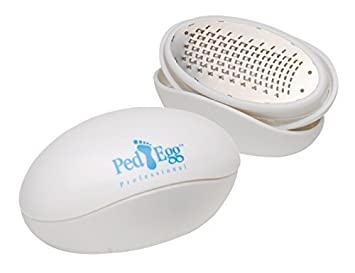what is a ped egg?

If you’ve watched TV in the past 10 years, chances are, you’ve seen the Ped Egg infomercial. This crafty little egg-shaped tool promises to quickly and painlessly file off dead, calloused skin while conveniently collecting shavings for clean and easy disposal. The Ped Egg is user-friendly AND budget-friendly, priced at a measly $10.00. That’s a small price to pay for perfectly filed feet, right? Well, not quite. Even for the bargain price, this tool will end up costing you a lot more than you might think.
Is it safe to use?
Let’s face it, this is the question everyone wants to know. To put it simply, we would definitely NOT recommend the Ped Egg for at-home foot care. There are too many risks that come with using this tool that will end up causing more problems in the long run. Here are a few reasons why the Ped Egg is NOT Podiatrist-approved.
Diabetics… Just No
If you’ve ever read our blog, visited our website or checked out any of our social media, you probably could’ve guessed that the Ped Egg is especially off-limits for diabetic patients. Trimming calluses is always a delicate task, but symptoms like neuropathy and poor circulation put diabetics at an even higher risk of developing serious healing problems in their feet. In fact, the American Diabetic Association recommends that all diabetic patients regularly receive professional podiatric care to minimize the risk of infection, open wounds, etc.
If a diabetic patient accidentally broke skin or created an open wound while using the Ped Egg, there is a high likelihood that the injury would go unnoticed and untreated. Even if it was addressed by a professional right away, the healing process would be much more intensive and difficult for a diabetic patient.
Nobody Needs An Open Wound
Open wounds are especially bad for diabetics, but they aren’t exactly ideal for other patients either. Most users have little to no knowledge of how to appropriately trim a callus, which drastically increases the risk of creating accidental punctures and wounds. Often times, patients get “trim-happy” and end up cutting into and damaging healthy skin. If these wounds are too small to see, or simply go unnoticed, the patient is at risk of developing serious infection. Our feet touch absolutely everything, especially if we walk around barefoot, so it’s incredibly easy for germs to find their way in to our body through wounds in our feet.
Do you know what you’re trimming?
Sometimes when patients are trimming their own calluses, they come to find out that they weren’t actually trimming a callus at all. Plantar warts commonly develop on the bottom of feet and are often mistaken for calluses. Warts are formed through exposure to the wart virus, and cutting into them with a filing tool opens the virus up for spreading. Once the virus is open and exposed, it can easily spread to other parts of the body as well as other people. Simply sharing a shower with someone who has an open wart can cause the virus to spread.
What can i use to remove a callus?
If you insist on removing calluses and dead skin at home, pumice stones are a great alternative to the Ped Egg. They are much gentler and less invasive than cheese grater-style filing tools, making them much safer for patients to use on their own. You can also always make an appointment with your local podiatrist and have your calluses professionally trimmed.
Interested in learning more? Contact Lexington Podiatry at 859-264-1411 or make an online appointment today.
